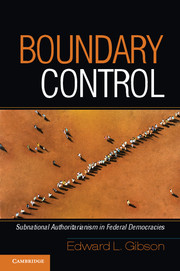4 - Boundary Control in Democratizing Argentina
Published online by Cambridge University Press: 05 January 2013
Summary
A close relationship exists between the constitutional structure and the authoritarian character of the political regime.
In 1983 party competition erupted across Argentina's federal political system unlike any other time in its history. After decades of military governments and restricted democratic regimes, free elections transformed the country's political landscape. Two national parties, the Unión Cívica Radical (Radical Party [UCR]) and the Partido Justicialista (Peronist Party [PJ]) dominated competition in national and subnational elections. In presidential politics, the Radical Party had unshackled the country from the “iron law” of Argentine elections, which had stipulated the invincibility of the Peronist Party whenever elections were free and fair. Political observers hailed the emergence of a truly competitive two-party system in national politics.
The competitive national wave put pressure on the parochial worlds of provincial politics. Boisterous contests between parties emerged not only in provinces with long histories of political pluralism but also in sleepy oligarchies across the country’s periphery. In several of these provinces local Peronist politicians, accustomed for decades to the job security of clan-controlled patronage machines, found their grips on the local polity weakening. Once-hegemonic systems became competitive as an ascendant national Radical Party bolstered local opposition parties.
- Type
- Chapter
- Information
- Boundary ControlSubnational Authoritarianism in Federal Democracies, pp. 72 - 111Publisher: Cambridge University PressPrint publication year: 2013

